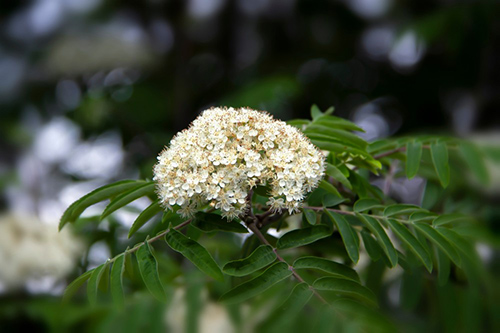Contents
Rowan grows isolated among other mountain trees and does not form bushes. Its flamboyant fruits are delicious for birds. In some cities, rowan trees are grown as ornamental plants. These are elegant and long-living trees: many live more than one hundred years.

Rowan Scientific Facts
- Scientific Name – Sorbus aucuparia L.
- Other Names – European mountain ash, mountain ash, sorb apple.
- French – Sorbier.
- Spanish – Serbal silvestre.
- Environment – Spread, but not widely, all over mountainous regions in warm climates in Europe.
- Description – Tree or shrub of the Rosaceae family, growing up to 6 m high, with grey, smooth bark and small white flowers. Its fruits are red or orange berries hanging in clusters.
- Parts of the plant used medicinally – The berries (fruit).
Common Rowan
Common rowan (Sorbus domestica L. = Pyrus Domestica Smith) renders more giant fruit than the wild rowan tree, similar to loquats. These fruits become brown when ripe in the fall. These sorb apples are more tasteful than the wild rowan, and their properties are identical.
Healing Properties
The fruits of the rowan tree contain several organic acids (sorbic, malic, citric, and succinic), sugars, pectin, tannin, and a high amount of vitamin C (up to 80 mg per 100 grams).

In German countries, these fruits are supposed to have many medicinal properties, though only the following ones have been proven:

- Astringent – Because of their content of tannin, they render suitable results for treating diarrhea and colitis, both acute and chronic. These astringent properties are partially balanced with the pectin they contain, which exerts a mild laxative effect. This combined action has a regulating and normalizing effect on the intestinal tract.
- Antiscorbutic and invigorator—Due to their vitamin C and organic acids content, rowan tree fruits are recommended for people lacking vitamin C, with fever diseases, influenza, colds, exhaustion, and weakened or recovering people.
- Mild diuretic and emmenagogue (promote menstruation).
How to use Rowan
The fruits are edible only when ripe, in fall, when they become softer and darker. If eaten when not completely ripe, they offer a strong, hoarse flavor in the mouth and are an irritant. A handful of fruit per day can already exert therapeutic effects. They can also be dried or prepared in purée after being cooked. The usual dose is 3 to 5 spoonfuls, three times a day.
DISCLAIMER: All content on this website is presented solely for educational and informational objectives. Do not rely on the information provided as a replacement for advice, diagnosis, or treatment from a qualified medical expert. If you are pregnant, nursing, or have any preexisting medical concerns, talk to your doctor before using any herbal or natural medicines.
REFERENCES
- George D. Pamplona-Roger, M.D. “Encyclopedia of Medicinal Plants.” George D. Pamplona-Roger, M.D. Encyclopedia of Medicinal Plants. Ed. Francesc X. Gelabert. vols. 2 San Fernando de Henares: Editorial Safeliz, 2000. 535. Print.
- USDA Food Database: https://fdc.nal.usda.gov/
- Ethnobotanical studies: https://ethnobiology.org/
